Food explorer Maeve O’Meara joins one of the senior statesmen of Chinese food—chef and teacher Robert Ho—to learn what basic ingredients are needed for a Chinese pantry.
Chef Anthony Lui from Melbourne’s acclaimed Flower Drum shows some of the behind the scenes secrets to a good stir fry. Shanghai born chef Chris Yan shares his favorite comfort food recipe—a melting flavorsome eggplant dish. We learn how to look like an expert when ordering yum cha! Maeve also prizes the recipe for salt and pepper squid from her friend, veteran restaurateur Ying Tam and learns how to make a healthy delicious steamed snapper with chilli, lemon and black bean sauce from rising star Frank Shek at China Doll on Sydney’s Finger Wharf.
Apprentice chef Connie Kam from Golden Century gives the rundown on some of those often mysterious Chinese vegetables and what to do with them...plus the extraordinary noodle-pulling skills of Chef Happy Kuk Cho Kok of Melbourne’s Fortuna Village Restaurant in Melbourne and a wobbly wonderful mango dessert by Rosetta Lee from Kam Fook Seafood Restaurant.
Click here for the recipes featured in this episode.
About China
China is a large country in East Asia. With nearly 4,000 years of continuous history, China is one of the world's oldest civilizations.
For centuries China stood as a leading civilization, outpacing the rest of the world in the arts and sciences, but in the 19th and early 20th centuries, the country was beset by civil unrest, major famines, military defeats, and foreign occupation.
After World War II, the Communists under MAO Zedong established an autocratic socialist system that, while ensuring China's sovereignty, imposed strict controls over everyday life and cost the lives of tens of millions of people. After 1978, MAO's successor DENG Xiaoping and other leaders focused on market-oriented economic development. For much of the population, living standards have improved dramatically and the room for personal choice has expanded, yet political controls remain tight.
China since the early 1990s has increased its global outreach and participation in international organizations.
Ancient & Imperial China:
Ancient China was one of the earliest centers of human civilization. Chinese civilization was also one of the few to invent writing, the others being Mesopotamia, the Indus Valley Civilization, the Maya and other Mesoamerican civilizations, the Minoan civilization of ancient Greece, and Ancient Egypt.
Historically, the cultural sphere of China has extended across East Asia as a whole, with Chinese religion, customs, and writing systems being adopted to varying degrees by neighbors such as Japan, Korea and Vietnam. Through its history, China was the source of many major inventions. It has also one of the world's oldest written language systems.
Chinese tradition names the first dynasty Xia, but it was considered mythical until scientific excavations found early Bronze Age sites at Erlitou in Henan Province in 1959. The first Chinese dynasty that left historical records, the loosely feudal Shang (Yin), settled along the Yellow River in eastern China from the 17th to the 11th century BC. The Qing Dynasty, which lasted until 1912, was the last dynasty in China.
In reality, Chinese history is not as neat as is often described and it was rare indeed for one dynasty to end calmly and give way quickly and smoothly to a new one. Dynasties were often established before the overthrow of an existing regime, or continued for a time after they had been defeated. For example, the conventional date 1644 marks the year in which the Manchu Qing dynasty armies occupied Beijing and brought Qing rule to China proper, succeeding the Ming dynasty. However, the Qing dynasty itself was established in 1636 (or even 1616, albeit under a different name), while the last Ming dynasty pretender was not deposed until 1662. This change of ruling houses was a messy and prolonged affair, and the Qing took almost twenty years to extend their control over the whole of China. It is therefore inaccurate to assume China changed suddenly and all at once in the year 1644.
In addition, China was divided for long periods of its history, with different regions being ruled by different groups. At times like these, there was not any single dynasty ruling a unified China.
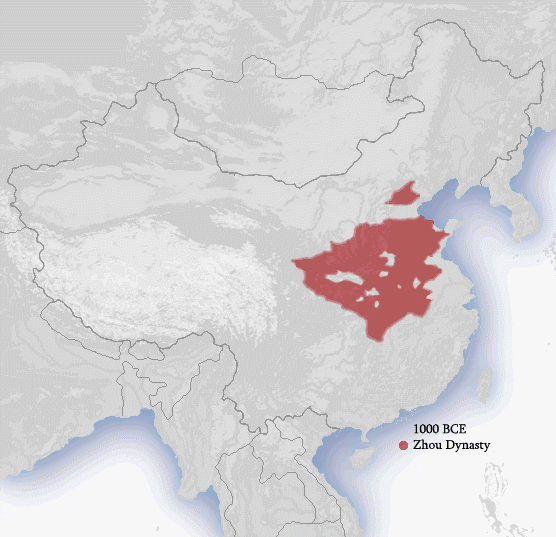 In the 19th century the Qing Dynasty adopted a defensive posture towards European imperialism, even though it engaged in imperialistic expansion into Central Asia. At this time China awoke to the significance of the rest of the world, the West in particular. As China opened up to foreign trade and missionary activity, opium produced by British India was forced onto Qing China. Two Opium Wars with Britain weakened the Emperor's control. European imperialism proved to be disastrous for China. Hong Kong was ceded over to the British. Thus, the "unequal treaties system" was established. Heavy indemnities had to be paid by China, and more territory and control were taken over by the foreigners. The weakening of the Qing regime, and the apparent humiliation of the unequal treaties in the eyes of the Chinese people had several consequences. One consequence was the Taiping Civil War, which lasted from 1851 to 1862. Although the Qing forces were eventually victorious, the civil war was one of the bloodiest in human history, costing at least 20 million lives (more than the total number of fatalities in the World War I), with some estimates of up to 200 million. Other costly rebellions followed the Taiping Rebellion, such as the Punti-Hakka Clan Wars (1855–67), Nien Rebellion (1851–1868), Miao Rebellion (1854–73), Panthay Rebellion (1856–1873) and the Dungan revolt (1862–1877). In the 19th century, the age of colonialism was at its height and the great Chinese Diaspora began. |
| ||||||||||||||||||||||||||||||||||||||||||||||||||||||||||||||||||||||||||||||||||||||||||||||||||||||||||||||||||||||||||||||||||||||||||||||||||||||||||||||||||||||||||||||||||||||||||||||||||||||||||||||||||||||||||||||||||||||||||||||||||||||||
While China was wracked by continuous war, Meiji Japan succeeded in rapidly modernizing its military and set its sights on Korea and Manchuria leading to the First Sino-Japanese War, which resulted in Qing China's loss of influence in the Korean Peninsula as well as the cession of Taiwan to Japan.
By the early 20th century, mass civil disorder had begun, and calls for reform and revolution were heard across the country. In a coup de'tat, Yuan Shikai overthrew the last Qing emperor, ending two thousand years of imperial rule in China. On 1 January 1912, the Republic of China was established, heralding the end of the Qing Dynasty.
Back to Menu  |
Modern China:
The Second Sino-Japanese War (1937–1945) (part of World War II) forced an uneasy alliance between the Nationalists and the Communists as well as causing around 20 million Chinese civilian deaths. With the surrender of Japan in 1945, China emerged victorious but financially drained. The continued distrust between the Nationalists and the Communists led to the resumption of the Chinese Civil War.
After the Chinese Civil War, mainland China saw a dramatic improvement in life expectancy, leading to an explosion in population. A series of disruptive socioeconomic movements started in the late 1950s with the Great Leap Forward and continued in the 1960s with the Cultural Revolution under Mao Zedong's Communist regimen. The Great Chinese Famine resulted in an estimated 30 to 36 million deaths. With the death of its first generation Communist Party leaders such as Mao Zedong and Zhou Enlai, the People's Republic of China (PRC) began implementing a series of political and economic reforms advocated by Deng Xiaoping that eventually formed the foundation for mainland China's rapid economic development starting in the 1990s.
In 1979, the Chinese government instituted a one child policy to try to control its rapidly increasing population. The controversial policy resulted in a dramatic decrease in child poverty. The law currently applies to about a third of mainland Chinese.
Post-1978 reforms in mainland China have led to some relaxation of control over many areas of society. However, the PRC government still has almost absolute control over politics, and it continually seeks to eradicate what it perceives as threats to the social, political and economic stability of the country. Examples include the fight against terrorism, jailing of political opponents and journalists, custody regulation of the press, regulation of religion, and suppression of independence/secessionist movements. In 1989, the student protests at Tiananmen Square were violently put to an end by the Chinese military after 15 days of martial law. In 1997, Hong Kong was ceded to the PRC by the United Kingdom.
China's position in the war on terror drew the country closer diplomatically to the United States. The economy continues to grow in double-digit numbers as the development of rural areas became the major focus of government policy. Many analysts assert that the modern PRC is one of the leading examples of state capitalism in the 21st century.
Economy:
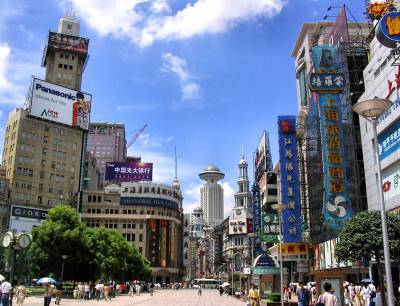 Today, the PRC is a member of the WTO and is the world's second largest economy after the United States. It is the world's fastest-growing major economy, with average growth rates of 10% for the past 30 years. The PRC owns an estimated $1.6 trillion of US securities. The PRC, holding US$1.16 trillion in US Treasury bonds, is the largest foreign holder of US public debt. China is the world's third-largest recipient of inward FDI, attracting US$92.4 billion in 2008 alone, and
China increasingly invests abroad, with a total outward FDI of US$52.2 billion in 2008 making it the world's sixth-largest outward investor.
Today, the PRC is a member of the WTO and is the world's second largest economy after the United States. It is the world's fastest-growing major economy, with average growth rates of 10% for the past 30 years. The PRC owns an estimated $1.6 trillion of US securities. The PRC, holding US$1.16 trillion in US Treasury bonds, is the largest foreign holder of US public debt. China is the world's third-largest recipient of inward FDI, attracting US$92.4 billion in 2008 alone, and
China increasingly invests abroad, with a total outward FDI of US$52.2 billion in 2008 making it the world's sixth-largest outward investor.
China is also the largest exporter and second largest importer of goods in the world. China became the world's top manufacturer in 2011, surpassing the United States. The PRC's success has been primarily due to manufacturing as a low-cost producer. This is attributed to a combination of cheap labor, good infrastructure, relatively high productivity, favorable government policy, and a possibly undervalued exchange rate. The provinces in the coastal regions of China tend to be more industrialized, while regions in the hinterland are less developed.
Although a middle-income country by Western standards, the PRC's rapid growth has pulled hundreds of millions of its people out of poverty since 1978. Today, about 10% of the Chinese population live below the poverty line of US$1 per day (down from 64% in 1978). Urban unemployment declined to 4% in China by the end of 2007, although true overall unemployment may be as high as 10%.
China's middle-class population (defined as those with annual income of at least US$17,000) has reached more than 100 million as of 2011, while the number of super-rich individuals worth more than 10 million yuan (US$1.5 million) is estimated to be 825,000, according to Hurun Report. Based on the Hurun rich list, the number of US dollar billionaires in China doubled from 130 in 2009 to 271 in 2010, giving China the world's second-highest number of billionaires. China is also now the world's second-largest consumer of luxury goods behind Japan, with 27.5% of the global share.
Demographics:
China's population is over 1.3 billion, the largest of any country in the world. According to the 2010 census, 91.51% of the population was of the Han nationality, and 8.49% were minorities. China's population growth rate is only 0.47%, ranking 156th in the world. The vast majority of China's population lives in the fertile plains of the east.
After the "opening up" of the 1980s, more religious freedoms were granted, and traditional beliefs like Taoism and Buddhism were supported as an integral part of the Chinese culture. Nowadays Shenism-Taoism and Buddhism are the largest religions in China with respectively over 30% (of which 160 millions, or 11% of the total population of the country, are Mazuists) and 18-20% of the population adhering to them, thriving throughout the country as the government is allowing them to spread.
Almost 10% of the population is composed of those regarded as non-Han ethnicities who following their traditional tribal religions.
Christians are 3-4% of the population according to various detailed surveys; Muslims are 1-2%. The remaining section of the population, ranging between 40% and 60%, is mostly agnostic or non-religious; purely atheists are 14-15%. Confucianism as a religion is popular among intellectuals.
Culture:
The Culture of China is one of the world's oldest and most complex cultures. The area in which the culture is dominant covers a large geographical region in eastern Asia with customs and traditions varying greatly between towns, cities and provinces. Today there are 56 distinct recognized ethnic groups in China. In terms of numbers however, the pre-eminent ethnic group is the Han Chinese. Most social values are derived from Confucianism and Taoism. Most languages in China belong to the Sino-Tibetan languages family, spoken by 29 ethnicities. There are also several major linguistic groups within the Chinese language itself. The most spoken varieties are Mandarin (spoken by over 70% of the population), Wu, Yue (Cantonese), Min, Xiang, Gan, and Hakka.
Tourism:
Tourism in China has greatly expanded over the last few decades since the beginning of reform and opening. The emergence of a newly rich middle class and an easing of restrictions on movement by the Chinese authorities are both fueling this travel boom. China is the world's third most visited country in the world. The number of overseas tourists was 56 million in 2010. According to the WTO, in 2020, China will become the largest tourist country and the fourth largest for overseas travel.
Tourist resources in China can be divided into three main groups: natural sites, historical and cultural sites, and folk customs. China has 41 UNESCO World Heritage Sites, ranking third in the world. These sites comprise some of the most essential part of China's valuable and rich tourism resources.
The most popular tourist attraction in China is the Great Wall of China. Also popular are the Forbidden City in Beijing, which was the center of Chinese Imperial power, and the Terracotta Army of the Qin Dynasty Emperor's mausoleum in Xi'an, a vast collection of full-size terracotta statues of Chinese Imperial soldiers and others.
Throughout China a great many hotels and restaurants have been constructed, renovated or expanded to satisfy all levels of requirement, and there are now 9,751 hotels with star ratings. All large or medium-sized cities and scenic spots have hotels with complete facilities and services for both domestic and international visitors.
Even though English is becoming more and more popular in China, most Chinese people do not understand it. Some form of Chinese is virtually universal in China, with Mandarin as the standard form and many other varieties also in use; some, like Cantonese and Shanghainese, have tens of millions of speakers. Although many Chinese do not speak English, due to the educational system many Chinese near and in urban areas can read and write it, even though they may have difficulty with spoken English.
Chinese Cuisine
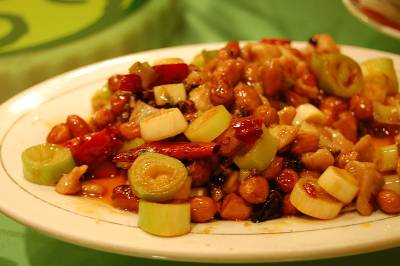 Chinese cuisine is any of several styles originating in the regions of China, some of which have become highly popular in other parts of the world—from Asia to the Americas, Australia, Western Europe and Southern Africa. As Chinese cuisine has spread globally, it has been adapted to local tastes and ingredients, and modified by the local cuisine, to greater or lesser extents. This has resulted in a number of forms of fusion cuisine, often very popular in the country in question, and some of these, such as ramen (Japanese Chinese) have become popular internationally. These include:
Chinese cuisine is any of several styles originating in the regions of China, some of which have become highly popular in other parts of the world—from Asia to the Americas, Australia, Western Europe and Southern Africa. As Chinese cuisine has spread globally, it has been adapted to local tastes and ingredients, and modified by the local cuisine, to greater or lesser extents. This has resulted in a number of forms of fusion cuisine, often very popular in the country in question, and some of these, such as ramen (Japanese Chinese) have become popular internationally. These include:
- American Chinese cuisine
- Canadian Chinese cuisine
- Indian Chinese cuisine
- Japanese Chinese cuisine
- Korean Chinese cuisine
- Pakistani Chinese cuisine
A number of different styles contribute to Chinese cuisine, but perhaps the best known and most influential are Sichuan cuisine, Shandong cuisine, Jiangsu cuisine and Guangdong (Cantonese) cuisine. These styles are distinctive from one another due to factors such as available resources, climate, geography, history, cooking techniques and lifestyle.
In most dishes in Chinese cuisine, food is prepared in bite-sized pieces, ready for direct picking up and eating. In traditional Chinese cultures, chopsticks are used at the table. Traditional Chinese cuisine is also based on opposites, whereby hot balances cold, pickled balances fresh, and spicy balances mild.
Staple Foods:
In general, rice is the major food source for people from rice farming areas in southern China. It is most commonly eaten in the form of steamed rice. Rice is also used to produce beers, wines and vinegars. In wheat farming areas in Northern China, people largely rely on flour-based food such as noodles, breads, dumplings and steamed buns.
Tofu, made of soybeans, is another popular product that supplies protein. Some common vegetables used in Chinese cuisine include bok choy (Chinese cabbage), Chinese Spinach (dao-mieu), On Choy, Yu Choy, and gailan (guy-lahn).
When comes to sauces, China is home to soy sauce, which is made from fermented soya beans and wheat. Oyster sauce, transparent rice vinegar, Chinkiang black rice vinegar, fish sauce and fermented tofu (furu) are also widely used. A number of sauces are based on fermented soybeans, including Hoisin sauce, ground bean sauce and yellow bean sauce. Spices and seasonings such as fresh root ginger, garlic, spring onion, white pepper, sesame oil are widely used in many regional cuisines. Sichuan peppercorns, star anise, cinnamon, fennel, cloves. To provide extra flavors to dishes, many Chinese cuisines also contain dried Chinese mushrooms, dried baby shrimps, dried tangerine peel, dried Sichuan chillies as well.
Desserts:
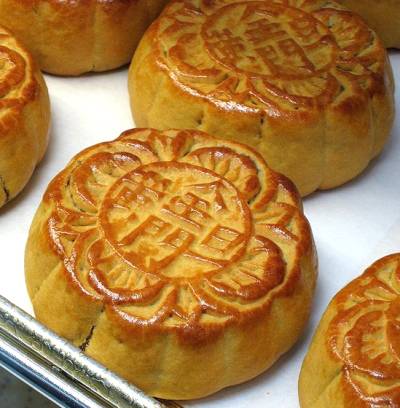 Chinese desserts are sweet foods and dishes that are served with tea, along with meals or at the end of meals in Chinese cuisine. Bings are baked wheat flour based confections, and include moon cake, Red bean paste pancake, and sun cakes. Chinese candies and sweets, called táng are usually made with cane sugar, malt sugar, honey, nuts and fruit. Gao or Guo are rice based snacks that are typically steamed and may be made from glutinous or normal rice.
Chinese desserts are sweet foods and dishes that are served with tea, along with meals or at the end of meals in Chinese cuisine. Bings are baked wheat flour based confections, and include moon cake, Red bean paste pancake, and sun cakes. Chinese candies and sweets, called táng are usually made with cane sugar, malt sugar, honey, nuts and fruit. Gao or Guo are rice based snacks that are typically steamed and may be made from glutinous or normal rice.
Ice cream is commonly available throughout China. Another cold dessert is called baobing, which is shaved ice with sweet syrup. Chinese jellies are known collectively in the language as ices. Many jelly desserts are traditionally set with agar and are flavored with fruits, though gelatin based jellies are also common in contemporary desserts. Chinese dessert soups typically consist of sweet and usually hot soups and custards.
Beverages:
China was the earliest country to cultivate and drink tea. Chinese tea is often classified into several different categories. Some of these are green tea, oolong tea, black tea, scented tea, white tea, and compressed tea.
Yellow wine has a long history in China, where the unique beverage is produced from rice and ranges between 10–15% alcohol content. The most popular brands include Shaoxing Lao Jiu, Shaoxing Hua Diao and Te Jia Fan.
Wheat, corn and rice are used to produce Chinese liquor which is clear and aromatic, containing approximately 60% alcohol. This also has a long history in China, with production believed to date back to the Song Dynasty. Some popular brands of liquor include Er guo tou, Du Kang, Mao Tai, Lu Zhou Te Qu and Wu Liang Ye.
Dining Etiquette:
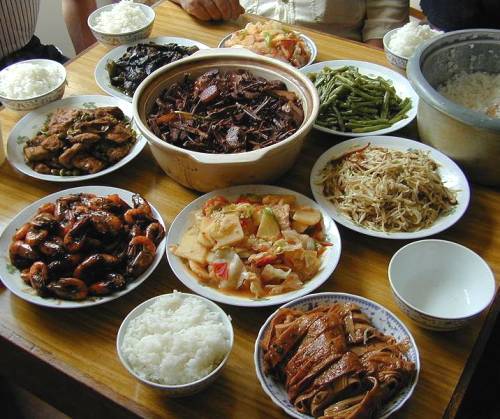 There are many eating manners that one must pay attention to which date from the time of ancient China. Etiquette governs nearly every action at the table. Some rules were out of courtesy and identity, and were called by ancient Chinese "respect for manners"; some others were traditional.
There are many eating manners that one must pay attention to which date from the time of ancient China. Etiquette governs nearly every action at the table. Some rules were out of courtesy and identity, and were called by ancient Chinese "respect for manners"; some others were traditional.
Whatever their origin, these rules show ancient China's dietary habits and food culture, and some of them are still followed in modern Chinese life. Compliance to these rules sometimes signals a person's status, culture, and family education to others. Because the custom of using banquets to solve problems in business, for friendship, and even in officialdom by the Chinese people, one should pay great attention to the manners by the table and especially to the Chinese eating taboos.
Eating is a dominant aspect of the Chinese culture, and in China, eating out is one of the most accepted ways to treat guests. Similar to Westerners drinking in a bar with friends, eating together in China is a way to socialize and deepen friendship.
Table etiquette is very important to Chinese people. In Chinese culture, using correct table manners is believed to bring “luck” while incorrect use will bring shame. Similarly, table etiquette indicates children’s educational status: holding chopsticks incorrectly leaves a bad impression and shames the parents, who have the responsibility of teaching them.
Since chopsticks are often used in many dishes in Chinese cuisine, knowing the correct chopsticks usage is essential. The most common chopsticks usages are the following:
- It does not matter whether you hold the chopsticks in the middle or at the end, but you should make sure that the ends are even.
- Chopsticks are not used to move bowls or plates.
- Chopsticks are not used to toy with one's food or with dishes in common.
- When not in use, chopsticks must always be placed neatly on the table with two sticks lying tidily next to each other at both ends.
- Treat chopsticks as extension of your fingers, and do not point at other people or wave chopsticks around.
- Do not suck the tips of chopsticks.
- Do not impale food with chopsticks.
- Do not point the chopsticks at another person. This amounts to insulting that person.
- Do not bang your chopsticks as though you were playing a drum. It implies you are a child, or a beggar.
- Do not stick chopsticks vertically in a bowl of rice; it implies the food is for the dead.
Episodes:
 |
AFRICAN: Wherever you are in Africa, no meal is complete without a starchy porridge known as fufu. |
 |
BRAZILIAN: An exuberant, colorful mix of Portuguese, African and native foods including some from the Amazon. |
 |
EGYPTIAN: Beans are used extensively and creatively as a source of protein, fibre, and comfort. |
 |
ENGLISH: "Meat & three veg" originated in the UK with dishes like roast beef, steak and kidney pie, and many more. |
 |
FRENCH: The French have elevated food into an art form. Nowhere else is so much attention paid to what people are going to eat and how. |
 |
HUNGARIAN: A fusion of simple peasant food & the elegant, highly developed cuisine from the days of the Austro Hungarian Empire. |
 |
INDIAN: A vibrant, intensely colorful cuisine. Each region of India has its own style of cooking and distinct flavors. |
 |
INDONESIAN: One of the most vibrant and colorful cuisines in the world, full of intense flavor and varied textures. |
 |
ITALIAN: An long-awaited introduction to the kitchens and restaurants of Australia’s top Italian chefs and home cooks. |
 |
JAPANESE: Refined and elegant, its preparation and presentation honed over the centuries so its flavors are pure and delicate. |
 |
JEWISH: While flavors of the Jewish palate are influenced by geography, the constant for Jews all over the world are the Kosher laws. |
 |
KOREAN: Some of the healthiest food on earth, with a near obsession with the fermented vegetable kimchi. |
 |
LEBANESE: Lebanese cuisine is generous and abundant, and this is some of the most exquisite food in the world. |
 |
MALTESE: The rocky island of Malta is home to some beautiful rustic recipes that sing of Mediterranean flavor and freshness. |
 |
MEXICAN: Authentic Mexican food is vibrant, spicy, delicious and fun. It varies according to which region its from. |
 |
MOROCCAN: One of the most cleverly balanced cuisines on earth; spices are used to enhance the flavor of dishes. |
 |
PAKISTANI: Full of marvelous and diverse dishes, it incorporates elements from its neighbors India, Afghanistan and Iran. |
 |
PERSIAN: From simple dips to hearty stews, food preparation is taken very seriously in Iran and is often a labor of love. |
 |
SOUTH AMERICAN: A fantastic fusion of culinary traditions from indigenous Indians, imported Africans, and the Spanish and Portuguese colonist. |
 |
SRI LANKAN: This beautiful spice island is a rich melting pot of every nationality that has visited and traded with it over the years. |
 |
SYRIAN: One of the highlights of Syrian food is mezza, a generous spread of small dishes and the prelude to even more food! |
 |
TURKISH: Nestled between Asia and Europe, Turkish food is an unique and exotic fusion with influences from many countries. |
Contact Us | Shop | Sitemap | Join Our Team | Investors | Advertise | Web Design Services
Community | Foodies' Choice | Meetup Groups | Chat | Blogs | Forums | Submit Your Site | Resources
